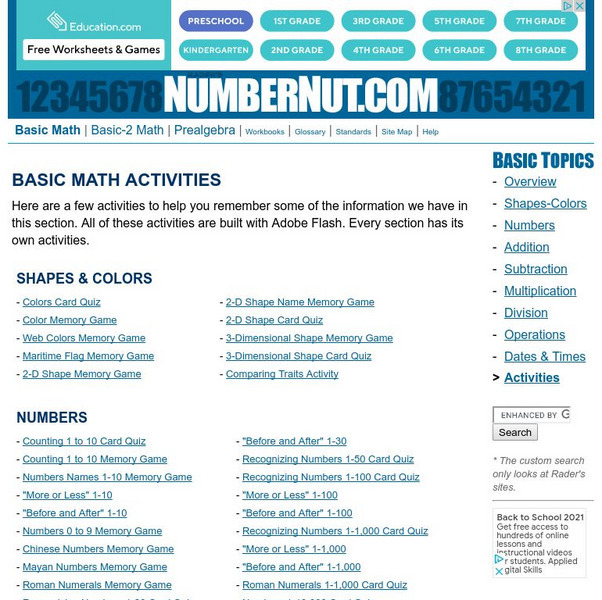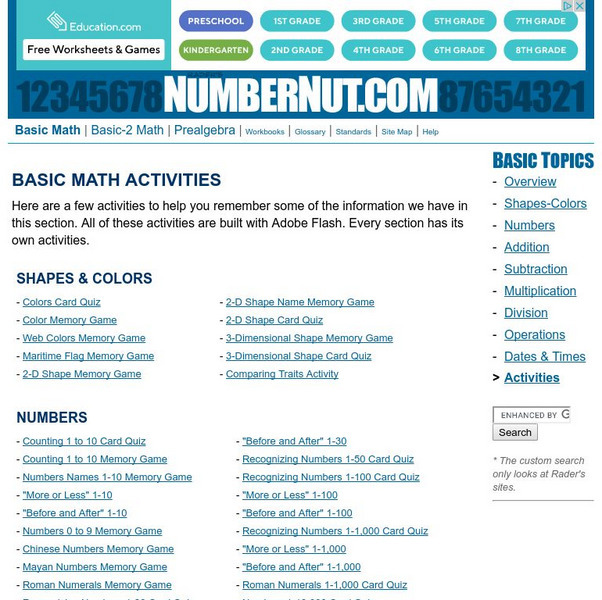PBS
Pbs Kids: How Do You Measure Up
Find out about measuring and take a fun "quizmo" to see what you've learned. Explore the types of measurements that are used in everyday life.
Better Lesson
Better Lesson: Sorting by Size
Sorting is an important foundational skills for kindergarten students to learn. Using attribute blocks to sort by size helps students practice comparing objects and prepares them to sort by other measurable attributes.
Better Lesson
Better Lesson: Sorting by Shape
Sorting is an important foundational skills for kindergarten students to learn. Using attribute blocks to sort by shape helps students practice comparing objects and prepares them to sort measurable attributes.
Better Lesson
Better Lesson: Learning to Sort Same and Different
Students will be able to compare objects.
Better Lesson
Better Lesson: It's All Equal to Me! (Talking About Squares)
Kindergarteners love to identify shapes in their environment. In order effectively do that, they must be able to recognize different shapes by their specific attributes. In this lesson kindergartners learn about the attributes of a square.
Better Lesson
Better Lesson: Math Centers Sorting
In order to pull small groups during math instruction, the rest of the students need engaging activities that they can complete independently. These simple sorting activities help students learn the procedures for completing math centers.
Better Lesson
Better Lesson: Babies & Big Boy Feet
Kindergarteners need a basic understanding of measurement that leads them to know that the smaller the unit the more it takes to measure the same object using less larger units.
Better Lesson
Better Lesson: How Does It All Compare?
Kindergarteners are introduced to comparing objects by their attributes. In this lesson, the kids compare objects by using the three attributes they have learned about.
Better Lesson
Better Lesson: Wow! That's Heavy!
Kindergarteners grasp the basic concepts of measurement quickly and this lesson provides a fun experience learning about weight.
Better Lesson
Better Lesson: It's That Tall?
Before entering first grade, young children need to have a basic understanding of measurement. They do not need to be able to use standard units of measurement, but they must be able to use the basic attributes to make comparisons in...
Better Lesson
Better Lesson: How Long? A Fishy "Tail"
Before entering first grade, young children need to have a basic understanding of measurement. They do not need to be able to use standard units of measurement, but they must be able to use the basic attributes of length.
Better Lesson
Better Lesson: Comparing Numbers Assessment
Students will compare numbers within 15, using symbols for "greater than", "less than", and "equal to". This lesson contains a printable assessment for this topic.
Better Lesson
Better Lesson: Measurement Comparing Length Day 1
Fish Eyes is a math story, but it is not focused on length. I use this book to have the students compare the length of the different fish in the story.
Better Lesson
Better Lesson: Measurement Comparing Height Day 2
Too Tall Tina is a book about a student who is obsessed with being too tall. It shows examples of many measurement comparisons.
Better Lesson
Better Lesson: Line Up, Shorty
Kindergarteners need a variety of experiences to ensure they build a strong foundation on a topic. This lesson gives them another opportunity to compare height, this time using themselves as the objects.
Better Lesson
Better Lesson: Measurement Comparing Height Day 1
Lining up from tallest to shortest is a great way to practice looking at height and exploring the terms shorter and taller.
Better Lesson
Better Lesson: Super Sorter! Multiple Attribute Sorting With a Venn Diagram
Understanding multiple attributes is an important mathematical process. The students use their knowledge of Venn Diagrams in this lesson to gain more knowledge about this concept.
PBS
Pbs: Count on It!: Episode 202 Math Is Everywhere, Part Ll
Blossom and Snappy discover a new window that Robbie put in the garage and decide to measure it. They discover the difference of standard measurement and non-standard measurement while making candies and during their visits to McDonald's...
Louisiana Department of Education
Louisiana Doe: Louisiana Believes: Eureka Math Parent Guide: Comparison of Length, Weight, Capacity, and Numbers to 10
A guide to support parents as they work with their students in comparison of length, weight, capacity, and numbers to 10.
E-learning for Kids
E Learning for Kids: Math: Sheep Farm: Measurement: Length & Mass
Meet George who lives on an Australian sheep farm. Can you help him with some chores?
NumberNut
Number Nut: More or Less: Comparing Values Less Than Thirty Cents
Compare two groups of coins and determine which group is worth more or less than the other. Money values are less than thirty cents. Words, not inequality signs, are used to compare the values. Score is kept as you go through activity.
NumberNut
Number Nut: Numbers and Counting: Comparing Numbers 1 Through 100
This interactive site explains how to compare whole numbers and offers a 10 problem quiz for practicing the skill.
NumberNut
Number Nut: Numbers and Counting: Comparing Amounts One Through Ten Activity
Quiz where the player compares two numbers between one and ten, which are represented by numerals and dots.
NumberNut
Number Nut: Numbers and Counting: Comparing Numbers One Through Thirty Activity
Quiz where the player compares two numbers between one and thirty, and states whether the first number is less than, equal to, or greater than the second number.








